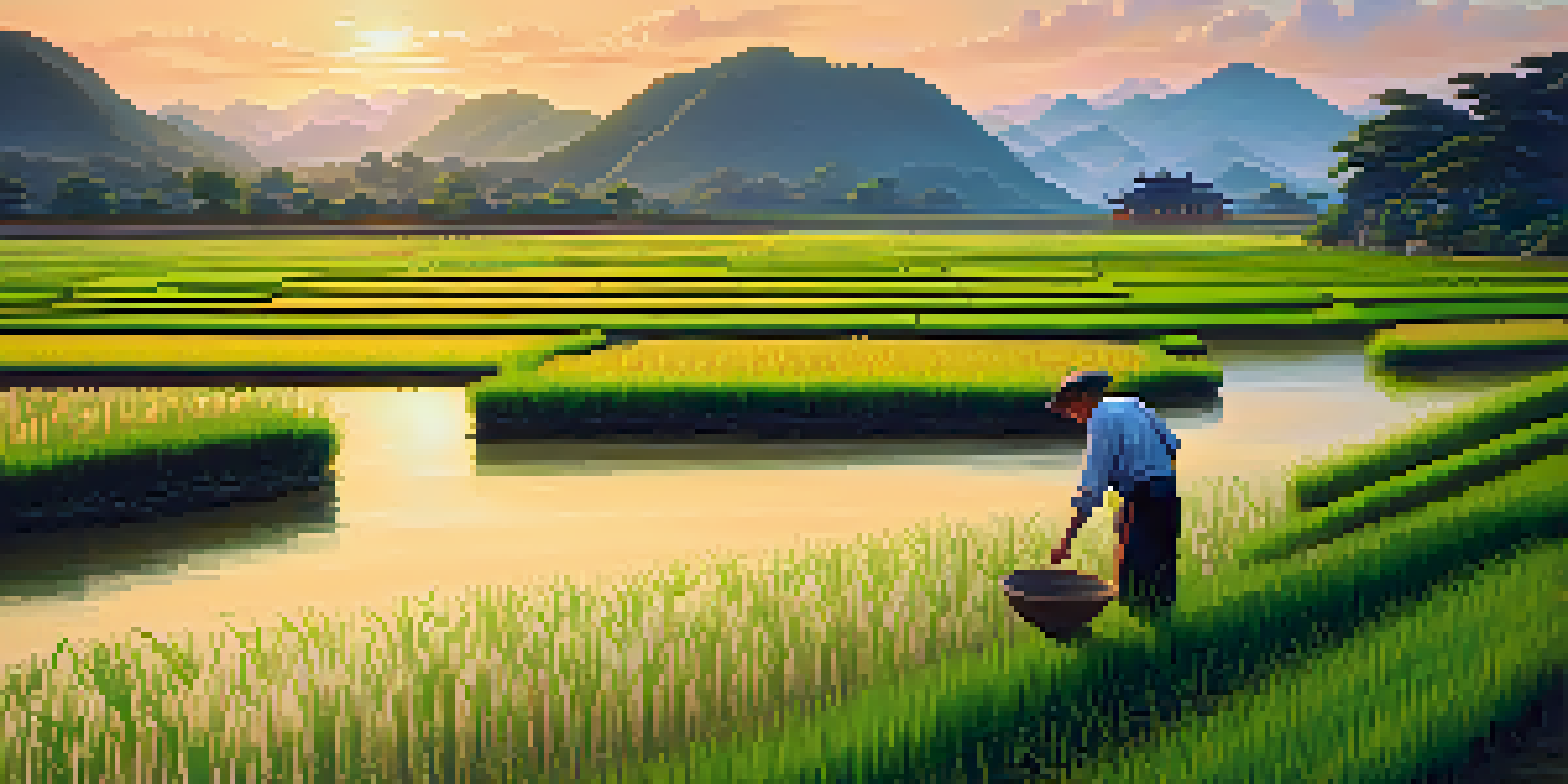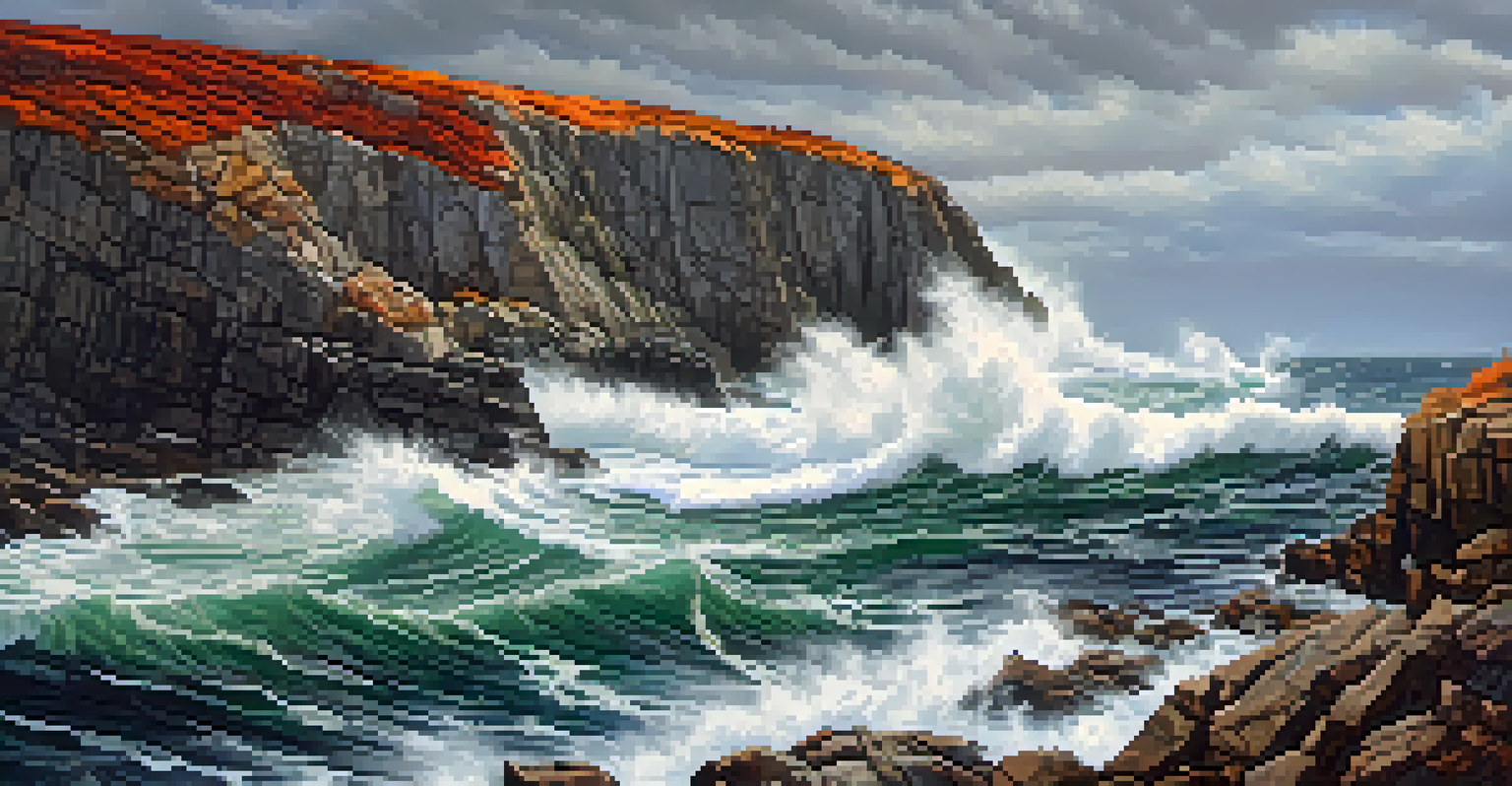Cultural Influences on Landscape Painting Traditions

Understanding Landscape Painting: A Cultural Lens
Landscape painting is more than just a depiction of nature; it's a reflection of the cultural values and beliefs of the time. Each brushstroke can tell a story, influenced by the artist's heritage and experiences. This genre of art serves as a visual diary, capturing how different societies interact with their environments.
Art is the most beautiful of all lies; it is a way of seeing the world through the lens of the artist's experience.
From the serene rice paddies of China to the rugged coastlines of New England, landscape painting varies widely across cultures. Artists don’t just paint what they see; they also infuse their work with the emotions and philosophies of their backgrounds. This interplay creates a rich tapestry of artistic expression, showcasing how landscapes can symbolize personal and collective identities.
As we delve into the world of landscape painting, it becomes clear that understanding the cultural context is essential. The landscapes we admire today are imbued with history, tradition, and the unique perspectives of the artists who created them. This connection between culture and nature invites viewers to appreciate not just the beauty of the landscapes, but also the stories they tell.
The Role of Geography in Artistic Expression
Geography plays a pivotal role in shaping landscape painting traditions. Different terrains, climates, and ecosystems influence what artists choose to represent. For instance, the sweeping plains of the American Midwest inspire vast, open compositions, while the dense forests of Northern Europe evoke a sense of mystery and depth.

In many cultures, specific landscapes are tied to folklore and mythology, further enriching the artistic narrative. For example, the majestic mountains of the Andes are often depicted in Peruvian art, celebrating the cultural significance of the region. Artists draw inspiration not only from the physical characteristics of their surroundings but also from the stories that make these places special.
Cultural Context Shapes Landscapes
Landscape painting serves as a visual diary that reflects the cultural values and beliefs of the time, showcasing how artists infuse their work with personal and collective identities.
By examining how geography influences landscape painting, we gain insight into the relationship between people and their environments. Artists often use their local landscapes as symbols of identity, pride, and belonging, capturing the essence of a place through their unique perspectives.
Cultural Narratives in Landscape Art
Cultural narratives are integral to understanding landscape painting traditions. Artists often weave their cultural stories into the fabric of their landscapes, creating pieces that resonate on multiple levels. For example, Indigenous artists may incorporate elements that reflect their spiritual connection to the land, adding layers of meaning to their work.
The painter tries to master color, and to create a living image from the dead, to give the viewer a sense of beauty and to evoke emotion.
These narratives can serve as a commentary on social issues, environmental concerns, or historical events, making landscape paintings powerful tools for advocacy. The landscapes portrayed are not merely decorative; they are imbued with purpose and intention, inviting viewers to engage with the artist's message. This aspect of landscape painting transcends aesthetics, prompting discussions about culture, identity, and responsibility.
By exploring these cultural narratives, we see how landscape painting can act as a bridge between the artist and the audience. It encourages viewers to reflect on their own relationships with nature and society, fostering a deeper appreciation for the art form.
The Influence of Historical Events on Landscape Painting
Historical events have always shaped the landscape painting traditions of various cultures. Wars, colonization, and migrations can alter not only the physical landscape but also the way artists perceive and depict their surroundings. For instance, during the Romantic era, artists like Caspar David Friedrich painted landscapes that reflected the tumultuous emotions of their time, using nature as a backdrop for human experience.
In regions affected by colonization, landscape paintings often reveal the tensions between indigenous cultures and colonial powers. Artists may depict their homeland under threat, using their work to express resistance or resilience. This dynamic interplay between history and landscape art creates a rich dialogue, highlighting the significance of context in understanding these works.
Geography Influences Artistic Choice
The geography of a region profoundly affects landscape painting, as artists draw inspiration from the unique terrains, climates, and cultural narratives tied to their environments.
As we examine landscape paintings through the lens of history, we gain insight into the socio-political climate that influenced the artists. These artworks serve as historical documents, capturing the essence of an era while encouraging viewers to consider the lasting impact of these events on cultural identity.
Religious and Spiritual Influences in Landscape Art
Religion and spirituality often play a significant role in landscape painting traditions. Many cultures view nature as a manifestation of the divine, and artists frequently reflect this belief in their work. For example, in Japanese art, landscapes often depict sacred mountains and serene gardens, symbolizing harmony between humanity and nature.
In Western art, the landscape has been used to evoke spiritual themes, with artists like Claude Lorrain capturing the beauty of Creation. These spiritual landscapes invite viewers to contemplate their own beliefs and relationships with the divine, creating a profound connection between the viewer and the artwork.
The integration of religious themes in landscape painting highlights the diverse ways cultures interpret their surroundings. By exploring these spiritual influences, we uncover a deeper understanding of how landscapes can serve as a canvas for expressing faith, reverence, and connection to something greater.
Modern Interpretations of Traditional Landscape Painting
As we move into the modern era, landscape painting has evolved dramatically, influenced by contemporary culture and technology. Artists today often blend traditional techniques with modern perspectives, challenging the conventions of landscape art. This fusion creates a dynamic space for innovation, where the boundaries of what constitutes a landscape are continually redefined.
Contemporary artists might incorporate mixed media or digital elements, reflecting the complexities of modern life and our relationship with nature. For example, artists like Olafur Eliasson create immersive installations that engage viewers directly with the landscape, prompting them to reconsider their experiences of nature. This shift invites a dialogue about environmental issues and the impact of urbanization on natural landscapes.
Modern Landscape Painting Evolves
Contemporary artists blend traditional techniques with modern perspectives, addressing current issues like climate change while redefining the boundaries of landscape art.
Through these modern interpretations, landscape painting remains relevant and responsive to the world we live in. By embracing change while honoring tradition, artists continue to explore the cultural influences that shape our understanding of the landscape.
The Future of Landscape Painting and Cultural Influence
Looking ahead, the future of landscape painting will undoubtedly be shaped by ongoing cultural influences and global challenges. As artists respond to climate change and the rapid pace of modernization, their works will reflect the urgency of these issues. This adaptability ensures that landscape painting remains a vital form of expression, connecting us to our environment in meaningful ways.
Moreover, the increasing interconnectedness of cultures due to globalization opens up new avenues for collaboration and inspiration in landscape art. Artists from diverse backgrounds can share their unique perspectives, enriching the dialogue surrounding landscape painting and fostering a deeper understanding of the world.

As we embrace the future, landscape painting will continue to evolve, serving as a mirror to our changing societies. By acknowledging and celebrating the cultural influences that shape this art form, we can appreciate the beauty and complexity of landscapes in all their forms.